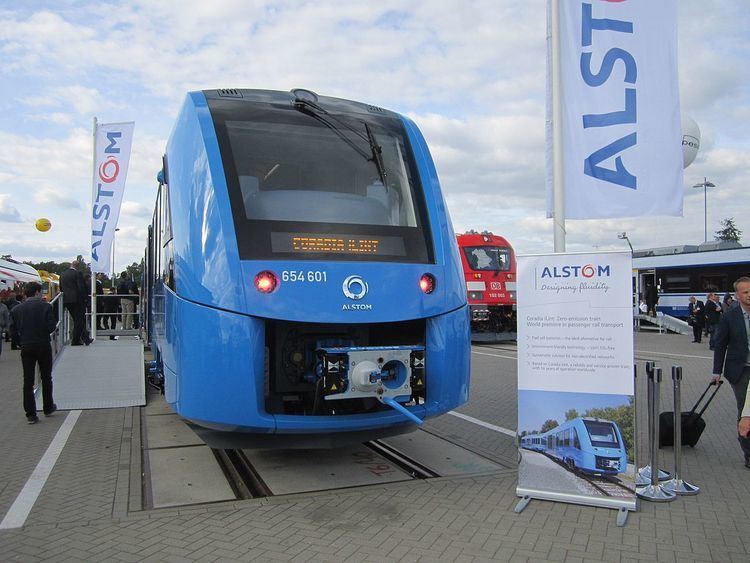Hydrail is the generic term denoting all forms of rail vehicles, large or small, which use on-board hydrogen as a source of energy to power the traction motors, or the auxiliaries, or both. Hydrail vehicles convert the chemical energy of hydrogen to mechanical energy, either by burning hydrogen in a hydrogen internal combustion engine vehicle, or by reacting hydrogen with oxygen in a fuel cell to run electric motors. Widespread use of hydrogen for fueling rail transportation is a basic element of the proposed hydrogen economy. The term is used extensively by research scholars and technicians around the world.
Hydrail vehicles are usually hybrid vehicles with renewable energy storage, such as batteries or super capacitors, for regenerative braking, improving efficiency and lowering the amount of hydrogen storage required. Potential hydrail applications include all types of rail transport: commuter rail; passenger rail; freight rail; light rail; rail rapid transit; mine railways; industrial railway systems; trams; and special rail rides at parks and museums.
Each year Appalachian State University and others organize an International Hydrail Conference, bringing together scientists, engineers and industrial experts working on the technology around the world in order to expedite deployment of the technology for environmental, climate, energy security and economic development reasons. Previous conferences have been held in Herning, Denmark; Valencia, Spain; Charlotte, North Carolina, Salisbury, North Carolina, Istanbul, Turkey, University of Birmingham, UK, Toronto, Ontario, Canada and Neumünster, Germany. Presenters at these conferences have included national and state/provincial agencies from the USA, Canada, Denmark, Italy, Japan, Korea, Russia, Turkey, the United Kingdom, the European Union and the United Nations (UNIDO-ICHET).
The term hydrail was coined on February 17, 2004 in the International Journal of Hydrogen Energy as a search engine target word to enable scholars and technicians around the world working in the hydrogen rail area to more easily publish and locate all work done in the discipline.
A hydrolley is a streetcar or tram (trolley) using hydrail technology. The term (for hydrogen trolley) was coined at the Fourth International Hydrail Conference, Valencia, Spain, in 2008, as a research-simplifying search engine target word. Onboard hydrogen-derived power eliminates the need for overhead trolley arms and track electrification, greatly reducing construction cost, reducing visual pollution and eliminating the maintenance expense of track electrification. The term 'hydrolley' is preferred to 'hydrail light rail' or other combinations which might connote external electrification.
Projects and prototypes
In 2002 the first 3.6 tonne, 17 kW, hydrogen-powered mining locomotive for Placer Dome was demonstrated in Val-d'Or, Quebec.
In April 2006 came the world's first hydrail railcar, which was developed by East Japan Railway Company
In October 2006, the Railway Technical Research Institute in Japan conducted tests on a fuel cell hydrail, a 70-ton intercity train .
In April 2007, The mini-hydrail from the Taiwan National Science and Technology Museum and Taiwan Fuel Cell Partnership combination made its first educational ride.
In 2007, The Railway Technical Research Institute in Japan built two 62 ton passenger cars, each with a 450 kW PEM fuel cell and a 150 kW battery.
In 2008, the East Japan Railway Company in Japan tested its experimental "NE Train" hybrid train fitted with two 65 kW PEM fuel cells and 19 kWh lithium ion batteries for a short period in the Nagano area.
In 2009, BNSF Railway unveiled the first hydrail Vehicle Projects HH20B switcher-locomotive, powered by hydrogen fuel cells.
In 2010, a 357-kilometre (222 mi) high-speed hydrail line was proposed in Indonesia. The rail link, now under feasibility study, would connect several cities in Java with a hydrogen-powered maglev system.
2011 FEVE and the University of Valladolid (CIDAUT) launched the FC Tram H2 Project in Asturias using a converted FABIOLOS series 3400 from SNCV. It can carry up to 30 passengers with a maximum speed of 20 km/h.
2012 The Hydrogen Train Project in Denmark is attempting to build Europe's first hydrogen powered train using hydrogen in an internal combustion engine.
2012 The mini-hydrail Hydrogen Pioneer Train from the University of Birmingham, a scaled powertrain for configuration testing.
2012 -2014 testing has been underway on the hydrail concept in China. In November 2010, Southwest Jiaotong University demonstrated their first hydrail prototype.
2012 - Anglo American Platinum (Amplats) in South Africa and Vehicle Projects Inc. launched 5 PEMFC Trident new era locomotives at the Dishaba mine with reversible metal-hydride storage for testing.
2014 - The German states of Lower Saxony, North Rhine-Westphalia, Baden-Württemberg and the Public Transportation Authorities of Hesse signed a letter of intent with Alstom Transport for trials with 2 fuel cell Alstom Coradia trains by 2018. On Sept 20, 2016 the newly developed iLint train was presented by Alstom. The train was produced at Alstom's Salzgitter factory. The state of Lower Saxony's local transportation authority has meanwhile ordered 14 trains of the type. Testing and approval by the German Federal Railway Authority Eisenbahn-Bundesamt will commence in fall 2016 and is expected to be completed by end of 2017. The trains are supposed to go into regular service on the Buxtehude–Bremervörde–Bremerhaven–Cuxhaven relation in December 2017. The trains have a maximum speed of 140 km and can travel between 600 – 800 km without refueling.
2015 - The University of Warwick are creating a Hydrogen powered locomotive.
2015 - The Downtown Oranjestad streetcar in Aruba went into service.
2015 - The Downtown Dubai Trolley Project streetcar is intended to go into service around Burj Khalifa and the Dubai Mall in Dubai.
2015 - CSR Sifang Co Ltd. showed its first 380-passenger tram in Qingdao, China.

